Cherries on the Monterey Bay? Is that possible? Do we have the chill? Depending on who you’re listening to, and what you are choosing as your planting site, the answers can run the gamut.
Cherryvale and other parts of Soquel were known for their extensive acreage devoted to commercial cherry orchards up into the 1960s. It is also common knowledge we are in an observable trend toward warmer average winter temperatures, so is successful cherry-growing a thing of the past?
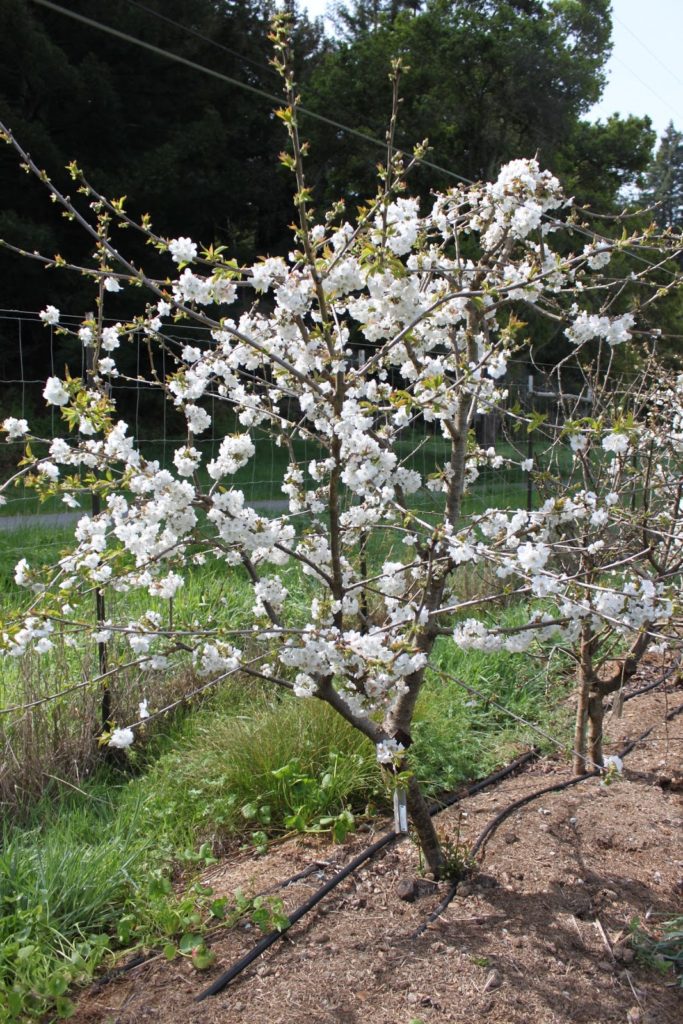
One respondent of a recent group discussion thread warned us not to even try, another concluded she hadn’t enough heat to ripen cherries, a third said we had plenty of chill to grow cherries here on the coast, except for down next to the beach. Where does the truth lie when all information comes in the form of a tangle of contradictions? How can one begin to tease out an accurate conclusion?
Some things we know about cherries: They demand high (700-1200 hours) chill-hours or portions or however you choose to quantify, but they bloom early and are frost tender when in growth. They also don’t like to get rained on when in bloom. It’s April 8th as I write, and the cherry bloom is on, but the frost free date is April 15th which usually means we might expect frost until then, but sometimes the frost never comes, and occasionally, it freezes almost into May.
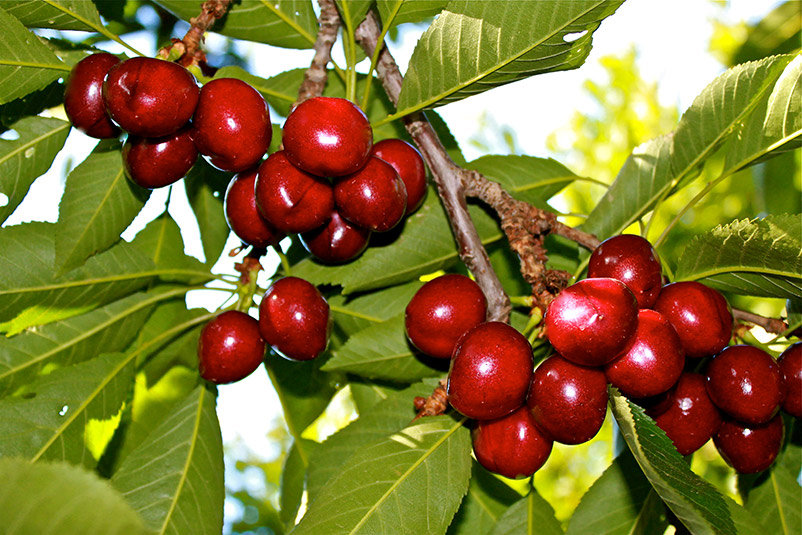
The trees are free growing, and can get quite big pretty fast, but need well drained sites, as the roots are susceptible to root rot, and can also be killed by gophers introducing bacterial diseases. The tops aren’t super healthy either, easily damaged by pruning during wet weather. Did I mention aphids, birds or pear slugs? Well those need to be contended with or forget it.
You can see why experienced growers say cherries are just looking for an excuse to fail. It is also the reason they sell for $8.00 a pound instead of the $2.00 fetched by the trusty apple. Well, that’s not the only reason they are valued so highly. If they weren’t so good, no one would bother with them at all. If you factor in the flavor with all the heartbreak, locally grown organic cherries should probably be selling for $20.00 a pound.
Choosing a Planting Site
So a lot of things to go wrong. But how to go right? First consideration is planting site.
Calculations say our area generally receives 300-700 chill hours ( hours between 45 and 32 degrees), not enough to make a cherry happy, but maybe enough if we use that to best advantage. Chill-hour measurements, remember, are general, and don’t accurately characterize every situation, each tree’s actual needs, or account for the fact that reasonable people disagree about how to count these hours. The dynamic method is currently considered the most biologically accurate means to calculate chill, and indicates we have piled-up a whopping 87 chill portions at the De Laveaga station this season. This is way more than even a Bing cherry needs (65) and more than twice what Lapins requires(35). The same station records only 610 chill hours, not quite enough for a Lapins. The Dynamic model, like a nice calculus professor who gives partial credit, recognizes that trees accumulate chill at temps under 54 degrees, instead of 45 degrees. So cherry growing in our area seems way more reasonable using the Dynamic method.
Since not every year is this good, it’s smart to locate cherries to maximize chill and the chance of making fruit in off years. Since a tree in full shade is going to accumulate far more chill than one in full sun, your cherry might do best in the weird, dark little corner of your yard you thought wasn’t good for anything.
Divining a cherry site is like experiencing a kind of epiphany, where the worst part of your yard suddenly has a purpose. Impediments and deficiencies become assets when employed shrewdly. Our great cherry sites sit behind north-facing hillsides, cypress hedges and 6’ fences, garages and timber bamboo groves. Oh, and that brings up another question: Can a cherry ripen if planted on the north side of a fence or mountain? Answer is yes! Cherries are forest trees, and one of the few that can be cozied-up 2’ from a north-facing wall, and still ripen fruit. Our area is cool for cherry growing, translating into late ripening times compared to the hot valleys. It’s not too cool. Cherries, like a lot of things, taste better ripened slowly.
Divining a cherry site is like experiencing a kind of epiphany, where the worst part of your yard suddenly has a purpose.
One oxymoronish situation that comes up is the better your site for chill, the worse it is for frost at bloom. My orchard sits at the bottom of a cold valley, mid–stream in a cold-air “river”. Plenty of chill, but I contend with some of the harshest, latest frosts in the county. Cold valley bottoms can also offer some of the worst draining soil situations. Heavy spring rains in orchards like mine can render the ground swampy and can drown freshly awakening, rapidly growing cherry roots.
There is however another aspect of spring rain to consider. It’s hard to know what to wish for during bloom time. Clear weather is often cold, so you don’t want that, as freshly pollinated baby cherries are killed at temps just a little below freezing. Rainy days seldom freeze, but branches covered in a thick garland of blossoms hold a lot of water, and need a chance to dry, or run a serious risk of brown-rotting the young fruit to the point of zero yield. We seldom get a late rain that threatens ripening fruit, but if it rains after the cherries begin to color, cracking can be a serious problem. These are hazards you might avoid with a temperature-controlled greenhouse to cover your trees…
Dealing with Pests
Even if you manage to site your tree well and draw some luck with the weather, certain cherries (like Rainier and Lapins, and Bing) seem particularly prone to aphid damage. Be prepared to use Tanglefoot on the trunks in he spring, before the damage is done. Pear slugs are sometimes a problem. I don’t know why some years and not others. Pick em off and smash them early in the season, or spray them with Bt.
If you succeed in all the above, the birds will celebrate your horticultural skill by wiping out your crop as it colors up. They will always eat them greener than you will. Juncos, Rufous-sided towhees, and Black-headed grosbeaks come as whole families to rob you. I net as the fruits just start to color.
Canopy-bed mosquito type nets work better than bird netting, because the fine mesh holds out the dreaded Cherry Vinegar Fly (Spotted wing Drosophila), and prevents them from hatching their larvae in your ripe fruit. The large maggots surround themselves with a mucus-like substance that tastes bitter and has a repulsive texture. If you don’t net, your cherries will either disappear into the beak of a bird, or be rendered inedible by the Vinegar fly.
Pruning Cherries
In order for you to keep your cherry trees small enough to fit inside a mosquito net, you need to practice twice-a- year pruning. If you prune your cherry trees in the rainy season, they won’t like it. They express this by dying. I prune during dry weather in the spring, as the trees go into flower, shortening all one year old wood back to the first leaf buds. This leaves only the flower buds at the base of the branch, and a few more down the branch, intact for cropping.
Basal buds make big cherries, and this also keeps the tree compact and dense with fruiting surface, instead of leggy with lots of blind wood.
After the fruit has ripened, I go in again and make shortening and thinning cuts to bring the tree back into reasonable size and shape after the seasons growth (Michigan State University is a great source of information about high density cherry training techniques).
Long lank growth on tree in the left-hand picture before pruning, threatens overreach and is cut and contained in the photo on the right.
Pollination
If you have only one or two trees, you’ll need to consider another important issue for both sweet and sour cherries: Cross Pollination. Even self-fertile cherries are more productive with a pollination partner. Check Orange Pippin, Dave Wilson, or Sierra Gold websites for pollinator partnerships, and maybe graft-on a pollinator branch to save space in your yard.
Sweet Cherry Varieties
Nobody said it was going to be easy, and our conditions and care aren’t perfect, but in our orchard, the trees seem to get points for close enough: There are always cherries to eat every year, and usually some to sell. The best producer is the Lapins. It is big and dark red, and very good, but not as good as Van or Bing. Rainier is also very productive, but low acid, and so not as good as it looks.
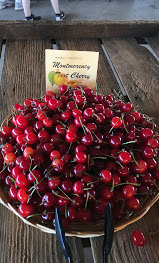
Montmorency Sour Cherries 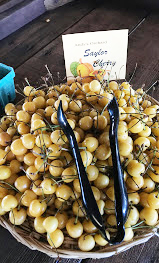
Saylor Cherries at Andy’s Orchard 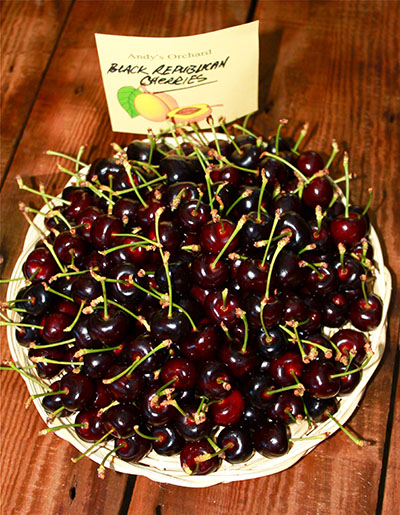
Black Republican Cherries
Royal Anne is an old French cherry that looks like Rainier, but tastes much better (more acid). Its smaller, ripens late, and produces a little lighter for me. Chelan is an early Bing type with a milder flavor, and seems to bloom a bit too early, which puts it in the way of more cold and wet. It rarely makes much, but that’s ok, since it’s not very good. Brooks also blooms early, but makes an early, broad-shouldered, great tasting fruit, and produces almost as well as Van.
Van is among my favorites, black/red and intensely sweet and tart. It’s a dependable producer, behind only Lapins and Rainier, and powerfully good. It’s not as big or as crunchy as Bing, but might be a bit tastier, if that’s possible. Bing is great, don’t know why I didn’t plant more of them. This year, with 6 new trees coming into bearing, will demonstrate some of its production potential. Ron’s Seedling is said to be the best sweet cherry grown in New South Wales. I think that means it’s good. My tree’s first heavy bloom is starting right now. Black Eagle is a small, soft English cherry (guigne type), silky and smooth in texture, intense and meaty in flavor. It fruits well on my small tree.
Waterloo is another British black cherry, consistent producer, very good flavor. Merton Late is a firm British cherry that looks like a Royal Anne, but is the last variety to ripen, is tasty, produces well, and is always a nice surprise for when you thought the cherries were gone. Benton is a bit of a disappointment, it’s big and dark red, meaty, ripens late, and tastes good, but doesn’t seem to make much. Stella, Skeena, Sweetheart, Attika, Hedelfingen, Black Gold, Black Republican have all been grafted over due to shy production, or indifferent flavor. Maybe they work better in other places: Andy Mariani of Andy’s Orchard in Morgan Hill, holds a series of fruit tastings every year. Their cherry event regularly features over 50 varieties and guided tours of his grounds. His Black Republicans are much better than mine were. This year’s cherry tasting is on Sunday, June 16, starting at 10:00 AM. There is no better opportunity to really learn something about cherries! Check out the four other tasting events listed on the Andy’s Orchard calendar for this summer). Oh, and finally, Black Tartarian is a lovely, big, soft, purple-black cherry, but since it’s an early bloomer, I didn’t include it in my cherry experiment. I only have one at my home, planted in the most unsuitable spot possible. As a testament to the negative effects of improper siting, in 30 years, it’s made probably 100 fruit.
Sour Cherries and Rootstocks
When it comes to sour cherries, Montmorency is the traditional variety, bright red skin, with light colored flesh and juice. I planted about fifty of them fifteen years ago. The Maheleb roots they were on were irresistible to the gophers. This is an East coast rootstock, and should not be planted anywhere gophers call home. All but ten were devoured within the year. Mazzard is a better rootstock, gophers don’t like it quite so much, but the trees on it seem to die after about seven years in my wet ground, or as soon as they’re big enough to make decent crops. Gisela 6 has worked well for me. It’s a nice size, tough and productive. My new favorite is the Adara (plum/cherry/peach hybrid) inter-stem on Myro plum rootstock. The plum roots are vigorous, lower chill, impervious to the high water table, gophers don’t like them so much, and generally much tougher than cherry.
I have one Montmorency left in my orchard, a very poor producer compared to the English Morello, which is a darker red cherry with dark red juice. English Morello is an easy cherry in our area. We planted a couple on the north side of a 6’ fence at our home in La Selva Beach. The fence-enhanced chill allowed them to make heavy crops on a regular basis until they died in the no-chill winter of 2014-15. Schatten Morello, perhaps my favorite sour, is even more dependable and delicious, bearing big, dark, sour cherries. Oblacinska is a very productive Morello-type from Yugoslavia, that ripens early, with the sweet cherries. Balatan, North Star, Kantorjanosi, Pandy 38, Sicilian Early: I’m still waiting for something positive to say about them.
Maybe Grow Cherries!
Not to give anyone the wrong idea: a really good location in this county can yield respectable crops of cherries most years. Profitable? Only if you don’t factor in the value of your time, water, netting, or other inputs. For an average location somewhere on the coastal terrace between Watsonville and Davenport, you need to cheat the chill as much as your ingenuity can manage: Use fences, buildings, hedges, water tanks, etc. to block the southern sun in winter. Start with easy cherries like Lapins and Morellos. I’ve seen enough situations to have a response for the opening question: “Can you grow cherries around here?” My answer would be a pretty confident “Maybe”.
You can definitely, as I have proven, mess it up: Plant in full winter sun, plant on Mahaleb roots, plant a difficult variety like Black Gold or Hedelfingen, prune it in the winter, fail to provide an appropriate pollinizer, forget to net it or apply Tanglefoot. Get it wrong on any one of these, and you stand little chance of being repaid for your trouble. If you do everything right, there is still the odd low-chill winter or bloom-time freeze, but those are about as common as really favorable years (like this one??) where everything does what it’s supposed to. It’s really a disease, this growing of cherries, like playing slot machines or betting on horses. We’ve never, in 14 years, hit the cherry jackpot, as there is always something standing between us and a bumper crop. We get enough fruit to eat, and that’s enough to keep us in the game. Still, every year, I find myself watching the clouds, reading the weather reports, gauging the blossom intensity, saying to everyone else’s amused skepticism: ”This could be the year!”
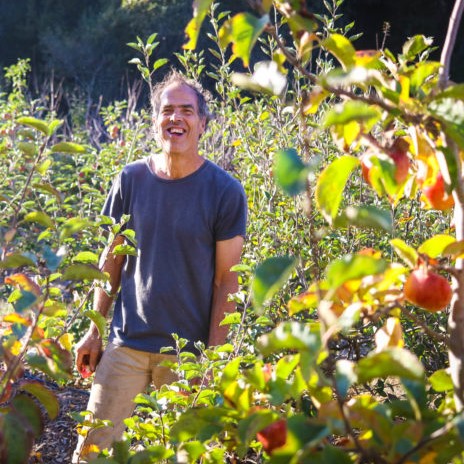
Freddy Menge grows select high-flavor fruit varieties at his orchard in Larkin Valley, Santa Cruz, is one half of the family run Epicenter Avocado Nursery, and has served as Chairman and other roles for MBCRFG.
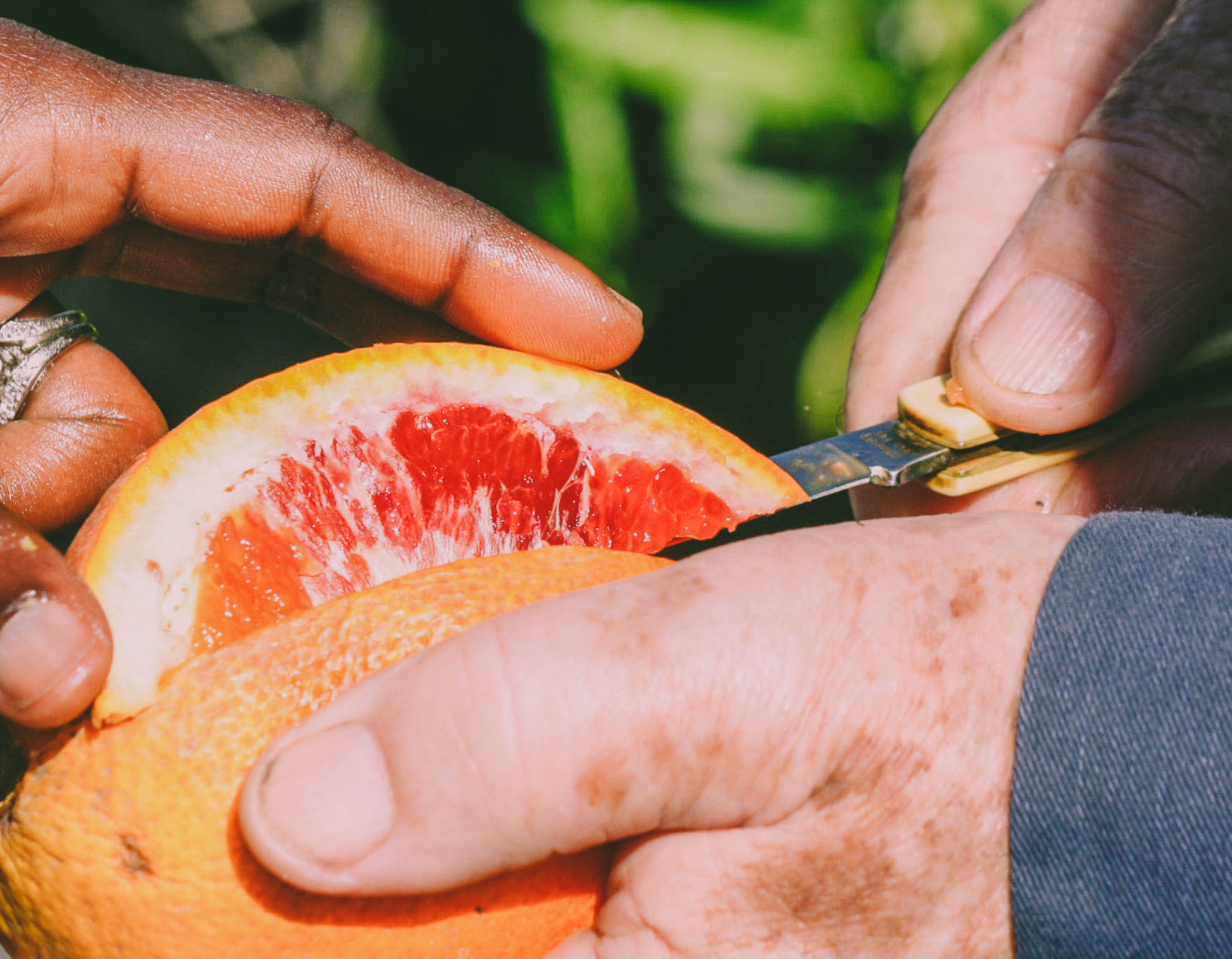
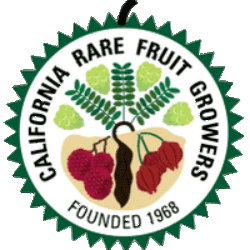
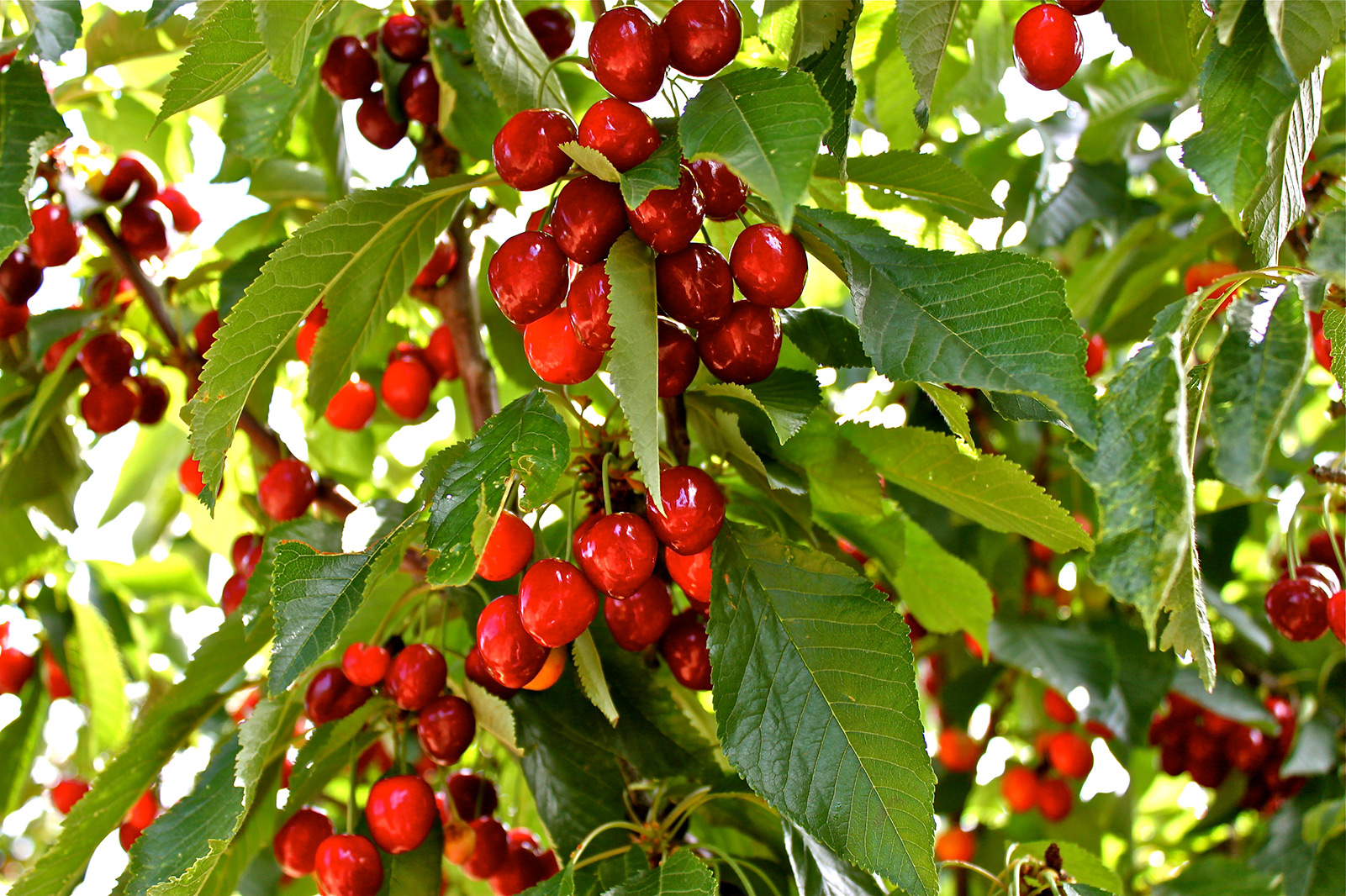
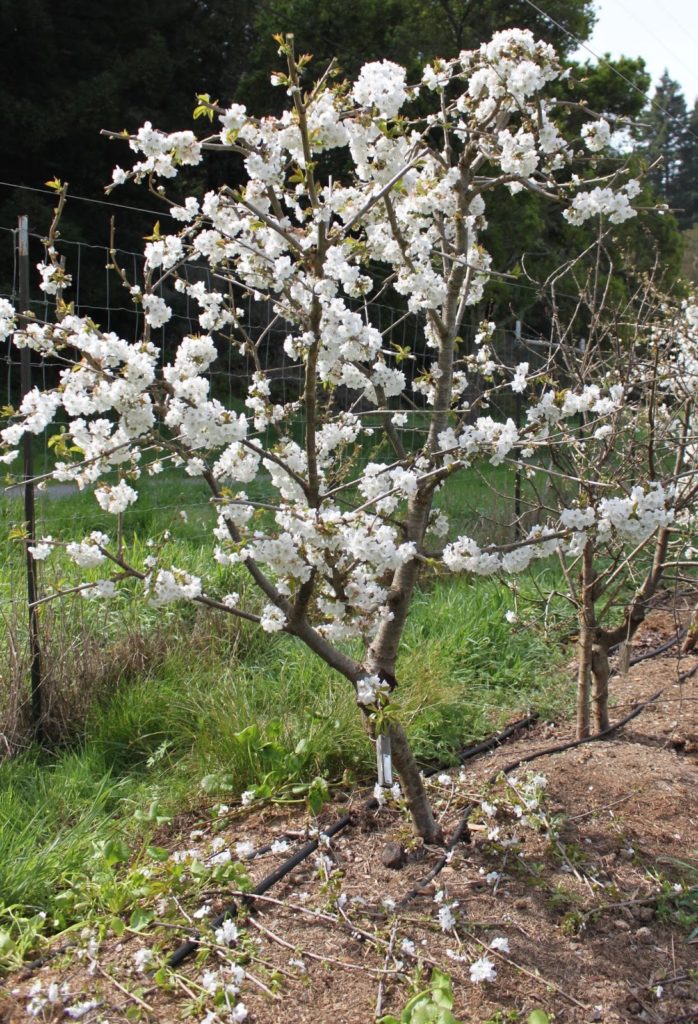
I want to plant cherries but can these plants be in bonsai because you don’t have enough land
Cherries are not ideally suited for container growning, but it certainly can be done. I would treat this as more of a hobby project, and not expect a substantial yield of cherries. I myself do grow a sour cherry tree in a 20gal container, from which I’m able to bake approximately one galette pastry with its yield per year.
What was the verdict on Ron’s Seedling this year? Did it live up to its reputation? Also, thanks for putting together this great write up on cherries! I’m going to roll the dice on my North facing hillside.
Ron’s Seedling was the worst performer of the year, making no fruit despite a decent amount of flowering. I will give it one more year.